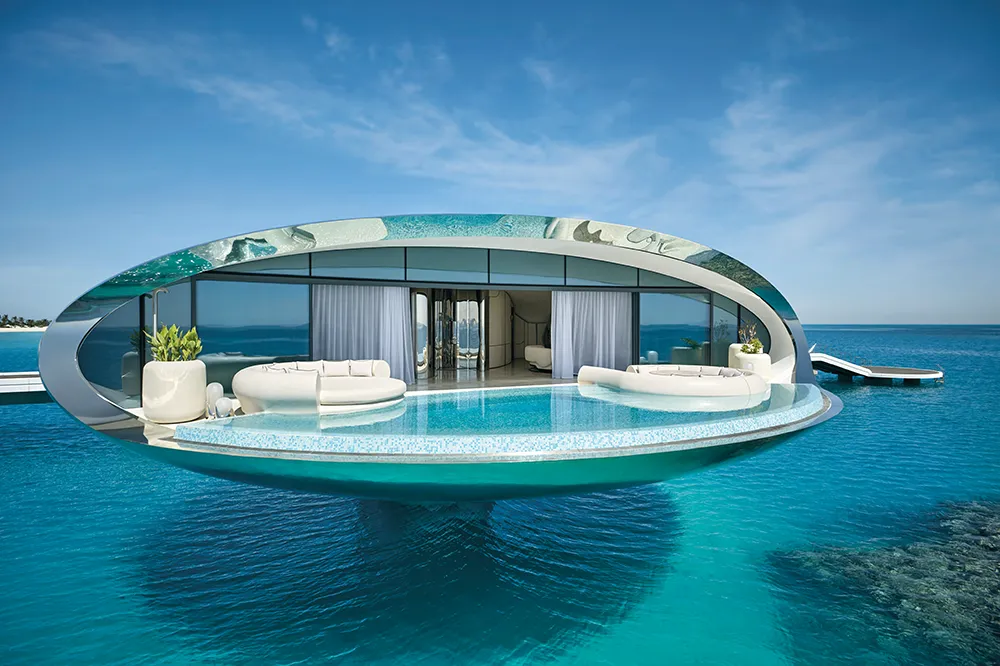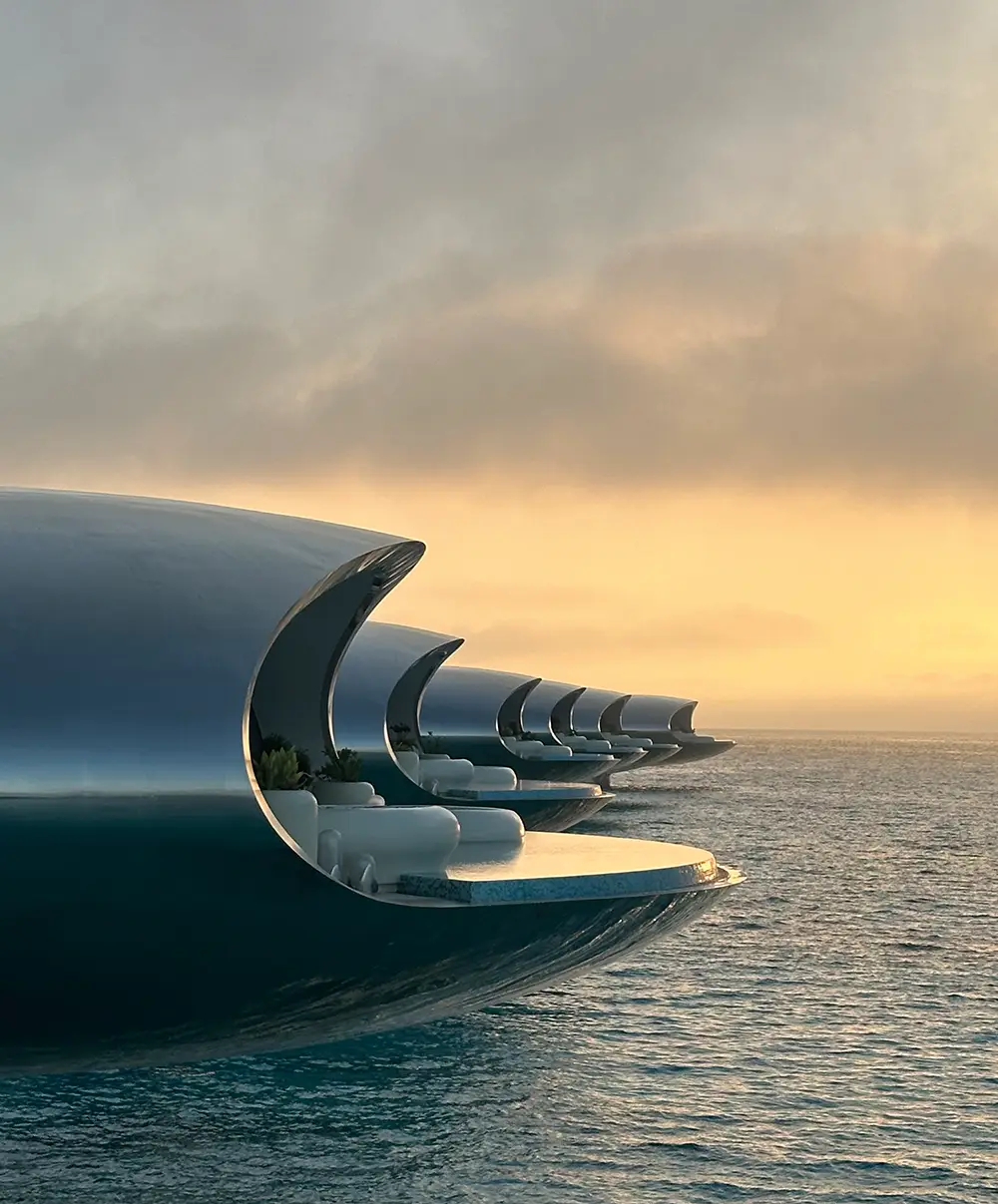Out of this world
A futuristic resort on Saudi Arabia’s Red Sea coast blurs boundaries, both physical and cultural.
By Georgina York
The new Shebara resort on Saudi Arabia’s Red Sea coast is so audacious, so unlikely, and so unexpected that it looks unreal. Made up of a chain of shimmering silvery orbs, it’s like a sci-fi fantasy, something beamed down from outer space. Baby UFOs dropped off by an extraterrestrial mothership perhaps, or the kind of structures we’ll be forced to live in on another planet when we finally destroy this one.
These otherworldly orbs are Shebara’s overwater villas, designed by Shaun Killa, the architect behind Dubai’s equally dazzling Museum of the Future. Shebara may not look of this world, but it somehow manages to fit into its pristine setting, reflecting sea and sky in every mirrored surface. Killa was inspired by air bubbles rising through water, resulting in a chain of structures that he describes as being like a string of pearls.
“We definitely played on the otherworldly,” he says. “Does it originate from nature, or is it from something beyond humankind? It’s definitely not a spaceship, but there’s something alien about it in an intriguing way.”
The futuristic nature of Shebara is a reflection of The Red Sea destination as a whole, a 28,000-square-kilometre megaproject encompassing sea, desert and mountains that, once completed in 2030, will be home to 50 resorts. Six are already welcoming guests, including Shebara, which opened last November. It’s a poster child for the destination, popping up on the social feeds of global influencers who, until now, were unlikely to have had the Kingdom on their bucket lists.
I catch my first glimpse of Shebara on the 35-minute speedboat journey from the mainland, bouncing over cerulean waters, past shallow reefs and mangroves where ospreys nest. We alight at a giant central pod where electric buggies transport us to our metallic cocoons. The orbs change appearance throughout the day. When I arrive, they shimmer, with the afternoon sun and turquoise waters playing on their surfaces. Later they reflect passing terns, wisps of cloud, the peachy tones of sunset, and a bright full moon. As I stand in front of my villa, I see myself distorted, like looking into a fairground house of mirrors.


Shebara’s shimmering orbs were designed by Shaun Killa, the architect behind Dubai’s equally dramatic Museum of the Future. The villas cantilever over shallow waters at the reef’s edge, one side open like a manta ray’s mouth. Each features an infinity-edge pool and circular lounging and dining areas. Throughout the day, the orbs transform as sunlight and the turquoise sea dance across their surfaces. Hero image by Ema Peter Photography; Top image by Red Sea Global Hospitality; Above by Nicola Chilton.
The villa is cantilevered over shallow waters on the edge of a reef, one side open like a gaping manta ray’s mouth, with an infinity-edge pool and circular lounging and dining areas. Floor-to-ceiling glass walls slide open to create living and sleeping spaces that flow seamlessly from indoors to outdoors. There are mirrored surfaces inside the villas too, on the entrance walls, around the bed, and on the refrigerator, a design curiosity that opens at the touch of a button like a cross between the doors of a Tesla and Darth Vader’s helmet. But the interiors, by Studio Paolo Ferrari, also incorporate soft textures and a neutral colour scheme. Walls are covered in cream leather. Polished oak details, tactile travertine and sculpted glass are reminiscent of a meticulously crafted superyacht.
Ferrari likens the villas to sea urchins. “The shell and internal parts of a sea urchin are intrinsically related, but they express the opposite qualities. The architecture of Shebara is like a protective shell that reflects the sky and ocean, and the interior is soft and tailored,” he says. “It was about creating a guest experience that looks to the future, while expressing a deeply human quality. We’re striving for a balance between timelessness and experimentation, between engineering and craftsmanship, with interiors that feel connected both to the architecture and nature.”
That connection is present when I wake before dawn to sit on my deck and watch the sun rise over the mountains on the mainland. One morning it’s hidden by a thick sea fog that rolls in, veiling the villas before being burnt off by the day’s heat. The following day the sky is cloudless, the silvery orbs reflecting syrupy, golden light and the sun’s rays bathing my deck in a warm luminescence.


The interiors strike a balance between timelessness and experimentation, engineering and craftsmanship with soft textures and a neutral colour scheme. Walls covered in cream leather and polished oak details are reminiscent of a meticulously crafted superyacht. Photos courtesy of Red Sea Global Hospitality.
While Shebara’s human-made elements may draw guests with their sheer drama, the Red Sea itself is the raison d’être for the property. The waters here are home to an extraordinarily rich biodiversity of marine life. Shebara’s house reef is an introduction to what lies beneath the surface. I jump from my villa’s swimming platform into a world of neon-hued coral to swim alongside pouting triggerfish, striped sergeant majors, and little half-and-half chromis. A yellow parrotfish crunches a chunk of coral, and I spot what I think is an algae-covered rock on the seabed until it reveals itself as a camouflaged Red Sea stonefish.
There are more marine treasures to be found on the outer reef at Ras Jameela, which I head to on a speedboat with Maldivian dive instructor Maaniu and Saudi captain Lafi. We have the reef to ourselves and jump into waters illuminated by crepuscular sunbeams where skinny needlefish glide close to the surface, improbably shaped boxfish swim with their fins moving in different directions, and a blue-spotted ribbontail ray lies flat on the sandy bottom. We move on to the coral pinnacle of Al Hariya, where the visibility is even better, and swim alongside swarms of silvery fusiliers moving as one, sleekly efficient barracuda, and clouds of tiny orange sea goldies. It’s here we’re joined by a hawksbill turtle, shy at first and then delightfully nonchalant, swimming beneath me with languid strokes of his strong flippers.
Back on land, I’m served an ice-cold drink at Saria by restaurant manager Augustine. The staff at Shebara are part of what makes a stay here so special, and many of them are in Saudi Arabia for the first time.
The futuristic architecture isn’t the only pioneering element of the resort. Shebara feels representative of a rapidly changing nation. It’s a place where you’re as likely to see groups of Saudis as Europeans. I meet local families trying snorkelling for the first time and stylish young women here for a weekend from Jeddah, on their way to an evening of stargazing in elegant abayas. And I find myself sitting alongside Italian, Russian, and Brazilian couples at dinner, reviewing the day’s photos.
On my last morning, I take one final jump from my villa into the water, seeing my reflection in the orb from beneath. And it causes me to reflect in more ways than one. Maybe one day there will be Shebara-like resorts popping up all over the world, or maybe the impracticality of keeping the orbs pristine in a setting where sun, sand and sea leave their marks will prove too much. If Instagrammability is a measure of success, the resort clearly gets top marks. For now, Shebara is one of a kind, blurring boundaries both physical and cultural, and creating a mood board of what the future of Saudi tourism may look like.



